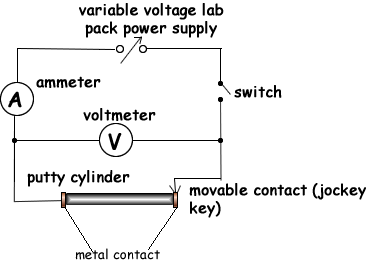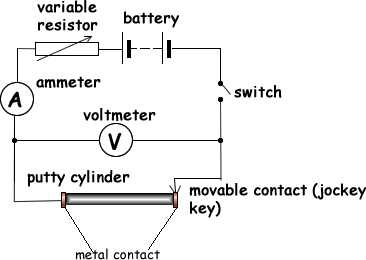Resistivity Question
Q4.

(a) A sample of conducting putty is rolled into a cylinder which is 6.0 × 10–2 m long and has a radius of 1.2 × 10–2 m. The resistivity of the putty is 4.0 × 10–3 Ωm.
(i) Calculate the resistance between the ends of the cylinder of conducting putty. Your answer should be given to an appropriate number of significant figures.
A = πr2 = π x (1.2 × 10–2 )2 = 4.52 x 10-4 m2
R = ρL/A
R = 4.0 × 10–3 × 0.060 /4.52 x 10-4 
R = 0.53 Ω 
Answer give to 2 significant figures 
(4 marks)
(ii) The putty is now reshaped into a cylinder with half the radius and a length which is four times as great. Determine how many times greater the resistance now is.
Halving the diameter will increase resistance by factor of 4  and increasing the length by a factor of 4 will increase resistance by factor of 4
and increasing the length by a factor of 4 will increase resistance by factor of 4  Therefore the resistance will be 16 times greater .
Therefore the resistance will be 16 times greater .
(2 marks)
(b) Given the original cylinder of the conducting putty described in part (a), describe how you would use a voltmeter, ammeter and other standard laboratory equipment to determine a value for the resistivity of the putty. Your description should include:
- a labelled circuit diagram,
- details of the measurements you would make,
- an account of how you would use your measurements to determine the result,
- details of how to improve the precision of your measurements.
QWC
Quality of Written Communication |
Descriptor |
Mark Range |
good - excellent |
(i) Uses accurately appropriate grammar, spelling, punctuation and legibility.
(ii) Uses the most appropriate form and style of writing to give an explanation or to present an argument in a well structured piece of extended writing.
[may include bullet points and/or formulae or equations]
An excellent candidate will have a working circuit diagram with correct description of measurements (including range of results) and processing. An excellent candidate uses a range of results and finds a mean value or uses a graphical method, eg I-V characteristics. They also mention precision eg use of vernier callipers. |
5-6 |
modest -
adequate |
(i) Only a few errors.
(ii) Some structure to answer, style acceptable, arguments or explanations partially supported by evidence or examples.
An adequate candidate will have a working circuit and a description with only a few errors, eg do not consider precision. They have not taken a range of results and fail to realise that the diameter needs to be measured in several places. |
3-4 |
poor -
limited |
(i) Several significant errors.
(ii) Answer lacking structure, arguments not supported by evidence and contains limited information.
Several significant errors, eg important measurement missed, incorrect circuit, no awareness of how to calculate resistivity. |
1-2 |
incorrect, inappropriate or no response |
|
0 |
voltmeter and ammeter connected correctly 
power supply with means of varying current 


The explanation expected in a good answer should include a coherent account of the procedure and include most of the following points.
• length with a ruler
• thickness/diameter with vernier callipers/micrometer
• measure voltage with a voltmeter
• measure current with an ammeter
• calculate resistance: R = V/I
• use of graph, eg I-V or resistance against length
• use of diameter to calculate cross-sectional area
• mention of precision, eg vernier callipers used at different orientations or full scale readings for V and I
• flat metal electrodes at each end to improve connection
(8 marks)
(Total 14 marks)


